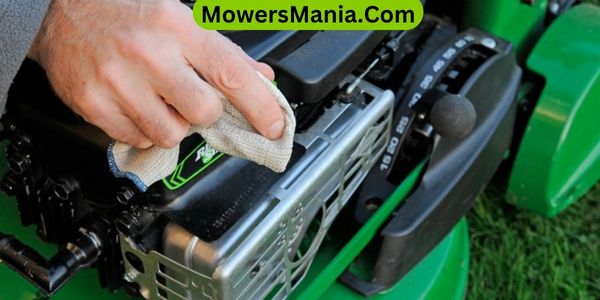Your lawn mower is like a trusty steed for your yard, and keeping it in top shape is key to a well-groomed lawn.
Maintaining a lawn mower may seem daunting, but with a few simple steps, you can keep it running smoothly for years to come.
From cleaning and sharpening to checking the oil and spark plug, a little regular TLC goes a long way.

In this guide, you’ll learn the essential maintenance tasks to ensure your lawn mower stays in prime condition.
With just a bit of effort, you can keep your mower humming and your lawn looking its best.
Cleaning the Lawn Mower
To maintain your lawn mower properly, you should regularly clean it after every use to prevent debris buildup and ensure optimal performance.
After mowing, turn off the mower and let the engine cool. Then, using a brush or a cloth, remove any grass clippings, dirt, or debris from the mower deck, blades, and undercarriage.
It’s important to check and clean the air filter, as a clogged filter can lead to poor engine performance. Simply remove the filter and gently tap it to remove dust and debris, or wash it if it’s dirty.
Additionally, make sure to inspect the spark plug and clean it if necessary. Wipe down the exterior of the mower to remove any grass or dirt, and check for any loose or damaged parts that may need attention.
Keeping your mower clean not only ensures that it looks good, but it also helps prevent rust and corrosion, extends the life of the machine, and maintains its cutting efficiency.
A clean mower is a happy mower!
Sharpening the Blades
You should sharpen the blades of your lawn mower regularly to ensure optimal cutting performance. Sharp blades make cleaner cuts, which promotes a healthier lawn by reducing the risk of disease and promoting faster healing of grass.
Here are some important tips to consider when sharpening the blades:
- Safety First: Always disconnect the spark plug before working on the blades to prevent accidental engine starts.
- Inspect for Damage: Check the blades for any cracks, bends, or extensive wear. If you notice significant damage, consider replacing the blades instead of sharpening them.
- Use the Right Tools: Invest in a blade sharpener or take the blades to a professional sharpening service to ensure they’re sharpened correctly.
- Maintain Balance: After sharpening, ensure that the blades are properly balanced. An unbalanced blade can cause excessive vibration and potential damage to the mower.
- Check Regularly: Make it a habit to inspect the blades at the beginning of each mowing season and periodically throughout the year to ensure they remain sharp and in good condition.
Changing the Oil
After sharpening the blades of your lawn mower, it is important to address the maintenance of the engine by changing the oil regularly. Changing the oil in your lawn mower is crucial for ensuring the engine runs smoothly and lasts longer.
Here’s a simple guide to help you with this essential maintenance task:
| Step | Description |
|---|---|
| Step 1 | Gather Supplies – You will need fresh oil, an oil pan, a funnel, and a wrench. |
| Step 2 | Warm Up the Engine – Start the mower and let it run for a few minutes to warm up the oil. |
| Step 3 | Drain the Old Oil – Place the oil pan under the mower, locate the oil drain plug, and carefully remove it to drain the old oil. |
| Step 4 | Replace Oil Filter – If your mower has an oil filter, now is the time to replace it with a new one. |
| Step 5 | Add New Oil – Using the funnel, fill the engine with the appropriate amount and type of new oil. Check the level with the dipstick to ensure it’s at the right level. |
Regularly changing the oil in your lawn mower will keep the engine running efficiently and prolong its lifespan.
Inspecting the Spark Plug

When maintaining a lawn mower, it’s essential to regularly inspect the spark plug to ensure proper functioning and optimal performance.
The spark plug is a critical component that ignites the air-fuel mixture in the engine, and a dirty or faulty spark plug can lead to issues such as hard starting, rough idling, and poor fuel economy.
- Check the Spark Plug Condition: Look for signs of wear, such as carbon deposits, erosion, or cracks on the insulator.
- Inspect the Spark Plug Gap: Use a gap tool to ensure that the distance between the center electrode and the ground electrode is within the manufacturer’s specifications.
- Clean or Replace the Spark Plug: If the spark plug is dirty or worn out, clean it with a wire brush and adjust the gap, or replace it with a new one.
- Tighten the Spark Plug: Ensure that the spark plug is securely tightened to the manufacturer’s recommended torque setting to prevent any leaks or misfires.
- Check for Spark: Before re-installing the spark plug, test for spark by grounding the plug to the engine and pulling the starter cord to verify that it’s producing a strong spark.
Checking the Air Filter
Regularly inspect the air filter of your lawn mower to ensure optimal performance and prevent debris buildup. The air filter plays a crucial role in preventing dirt, dust, and debris from entering the engine and causing damage.
To check the air filter, locate the filter housing, which is often on the side of the mower or under the cover. Remove the cover and take out the air filter.
Hold it up to the light and inspect it for dirt and debris. If the filter is clogged or dirty, it needs to be cleaned or replaced. A clogged air filter can restrict airflow to the engine, leading to reduced performance and efficiency.
If it’s a foam filter, wash it with soap and water, then allow it to dry completely before reinstalling. For paper filters, consider replacing them if they appear dirty or damaged.
Regular air filter maintenance is essential for the longevity and efficiency of your lawn mower. By keeping the air filter clean, you can ensure that your mower operates at its best.
Adjusting the Wheel Height

To achieve an even and well-manicured lawn, adjust the wheel height of your lawn mower using the provided lever for precise control. Proper wheel height adjustment ensures that your grass is cut to the desired length and helps maintain a healthy lawn.
Here’s how to adjust the wheel height:
- Position the Mower: Place the mower on a flat surface to ensure accurate adjustment.
- Locate the Adjustment Lever: Most mowers have a lever on each wheel for individual height adjustment.
- Adjust the Height: Move the lever to your desired height setting. Lower settings are suitable for shorter grass, while higher settings are ideal for longer grass.
- Check for Evenness: After adjusting the wheel height, examine the mower to ensure that all wheels are set to the same height for an even cut.
- Test the Height: Start the mower and carefully observe the grass cutting action to ensure the height is appropriate for your lawn.
Frequently Asked Questions [FAQs]
Can I Use Regular Gasoline in My Lawn Mower, or Do I Need to Use a Specialized Type of Fuel?
You can use regular gasoline in your lawn mower, but it’s best to use fuel with no more than 10% ethanol. This helps prevent engine damage and ensures optimal performance. Regular maintenance also keeps your mower running smoothly.
How Often Should I Replace the Lawn Mower’s Drive Belt?
You should replace the lawn mower’s drive belt every 2-3 years or if you notice signs of wear such as cracking or fraying. Regular inspection and maintenance of the drive belt will ensure smooth operation of your lawn mower.
Is It Necessary to Winterize My Lawn Mower if I Live in a Mild Climate?
Yes, it’s necessary to winterize your lawn mower even in a mild climate. This helps prevent potential issues with the fuel system and ensures a smooth start when you use it again in the spring.
What Is the Best Way to Store a Lawn Mower for an Extended Period of Time?
To store a lawn mower for an extended period, clean it thoroughly, drain the fuel or add a stabilizer, change the oil, and remove the spark plug. Store it in a dry, covered area to protect it.
How Often Should I Have My Lawn Mower Professionally Serviced?
You should have your lawn mower professionally serviced at least once a year. This will ensure that it continues to run smoothly and efficiently. Regular maintenance by a professional can help prevent costly repairs down the line.
Conclusion
So, there you have it! By regularly cleaning, sharpening, and maintaining your lawn mower, you can ensure that it continues to run smoothly and efficiently.
Don’t forget to also keep an eye on the oil, spark plug, air filter, and wheel height. With these simple maintenance tasks, your lawn mower will be ready to tackle any yard work that comes its way.
Happy mowing!



